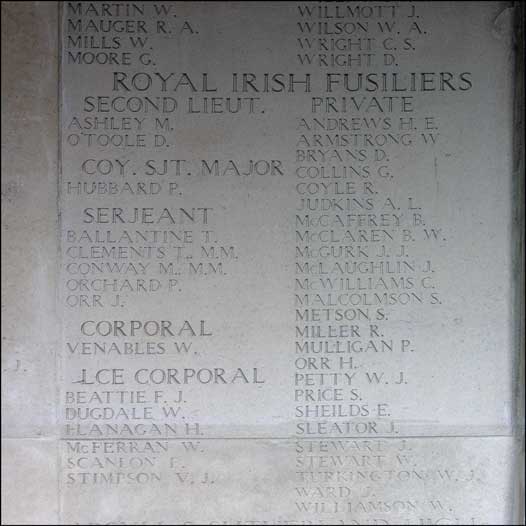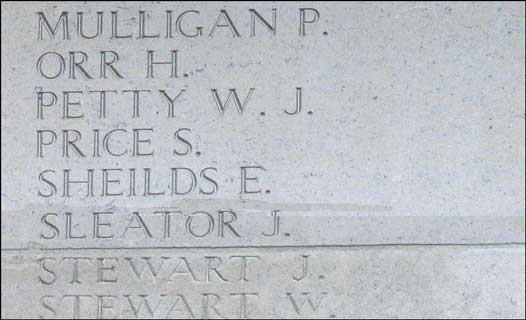![]() In memoriam
In memoriam ![]()
Private William Joseph Shaw Petty

William Joseph Shaw Petty was born on 21 August 1891 at 83 Grosvenor Street, Belfast, son of RIC sergeant Francis Petty and his wife Maria (nee Shaw). In 1911 he was living with his father, two sisters and a brother (his mother having died two years earlier) at 37 Broadway, St Anns, Belfast, and working as a draper.
It appears that soon after he emigrated to Canada. Around the time war was declared he enlisted in the 34th (Fort Garry Horse) Regiment at Winnipeg, Manitoba. However he then resigned in order to enlist in Ireland.
Petty joined the North Irish Horse at Antrim on 23 November 1915 (No.1944). He was made acting lance corporal on 10 December and acting corporal on 7 January the following year, before reverting to private at his own request on 4 April. The following month at Antrim he was disciplined for being absent off pass for two hours.
Petty embarked for France with a reinforcement draft on 3 August 1916, joining the 2nd North Irish Horse Regiment in the field at Flesselles eight days later.
In September 1917 the 2nd Regiment was dismounted and most of its officers and men were transferred to the 9th (Service) Battalion, Royal Irish Fusiliers – which was renamed the 9th (North Irish Horse) Battalion. Like most of the men, Petty was transferred to the battalion on 20 September. He was issued a new regimental number – 41406.
In November and December 1917 the 9th Battalion played a role in the Battle of Cambrai, first going into action in the attack on the village of Moeuvres on 22-23 November. The battalion war diary for those days reads as follows:
[22 November] The Battn moved up at 6.30 a.m. to a position N. of Bapaume & Cambrai Road arriving at 8.30 a.m. Here the Battn waited for an order to attack Inchi when Moeuvres was taken by the 12th Royal Irish Rifles. At 11.45 a.m. the 12th R. Ir. Rifles captured village of Moeuvres. It was unable to clear trenches East of village. At 5.30 p.m. Battn moved up to support 12th R. Ir. Rifles in the village of Moeuvres. At 5.45 p.m. 12th R. Ir. Rifles reported driven out of village. At 8.30 p.m. Battn less 'D' Coy counter attacked village of Moeuvres but was driven back to trenches immediately south of the village, where it took up a defensive position for the night.
[23 November] Battn attacked Moeuvres at 10.30 a.m. At 11 a.m. Battn reported in village. At 11.45 a.m. enemy counter attacked from trenches West of village. 12.15 p.m. counter attack driven off. At 4.30 .p.m village evacuated by Battn on account of supports not coming up. 5 p.m. 'C' & 'D' Coys took up position on Sunken Road South of village and 'A' & 'B' Coys went back to trenches North of Bapaume & Cambrai Road.
Casualties for 22nd & 23rd: Officers killed 1. Officers wounded 6. ORs 82 casualties.
Petty was one of the 82 casualties. Initially reported as wounded and missing, nothing more was heard of him. In 1918 his father wrote to Army officials in Dublin:
It is now nearly three months since my son William J Petty … was reported wounded and I have no further official news with regard to him since yours of the (26th?). Surely something must be known about him in 3 months. I cannot think he is alive or he would have written to me or got someone to write for him. Can you give me any further (..?..) regarding him if he is alive in France. If I knew even the worst it would relieve this terrible suspense. Hoping you will be able to give me some information for which I shall feel thankful.
It was not until October that year that Petty was officially recorded as ‘presumed to have died on or since' 22 November 1917.
As he has no known grave, Private Petty is commemorated on the Cambrai Memorial, Louverval, France, Panel 10. If his body was recovered by the Germans after the battle, it was probably buried in the German extension to the Moeuvres Communal Cemetery, and after the war re-interred in the British extension, in which lie 263 unidentified casualties.

Memorial images Copyright © Phillip Tardif with all rights reserved as set out in this Use of Material policy. Newspaper image from the Ballymena Weekly Telegraph of October 1918 kindly provided by Nigel Henderson, Researcher at History Hub Ulster.

